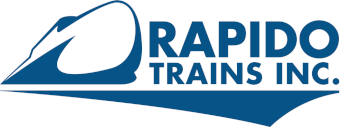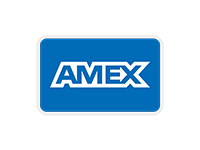Southern Pacific Dome-Lounge Car Masterclass
Southern Pacific Dome-Lounge Car
By Craig Walker with a lot of help from Robert J Zenk

It’s the 1950s: Mars Needs Women …
and Southern Pacific Needs Domes!
(Yes, we know … The film Mars Needs Women was released in 1968. But it sure felt like a 1950s film, didn’t it?)
In the 1950s, most of the western railroads featured dome cars to allow passengers the best view of the magnificent scenery along their routes. However, Southern Pacific – which operated passenger trains over some of the west’s most spectacular scenery, such as the Sierra Nevada’s Donner Pass, the Siskyou Mountains on the California-Oregon border, the Cascade Mountains in Oregon, skirting the Pacific Ocean along the California coast, California’s Tehachapi Mountains and the San Joaquin Valley … well, maybe not that one, as it is scenic in the same way America’s Midwest is scenic: it’s nice, but not “dome car scenic” – had somehow overlooked this selling point, and in the early-1950s began a plan to rectify the situation.
Frank H. Stengle Jr. designed a dome car that would be constructed on the frames of existing, but surplus, passenger cars and created a fleet of seven Dome-Lounge cars. SP 3600 was the first, built in 1954 on the frame of a 1937-built parlor-round end observation car, SP 2950. It proved that the plan was workable, and six more cars were constructed in 1955, using body kits provided by the Budd Company.
That unique car barnstormed over most of the SP passenger system in 1954, gauging traveler acceptance. Based on comment cards and test trip reactions, the six “production” cars of 1955 featured additional refinements – including slightly greater length, a longer dome space, taller side windows, and more cocktail seating. (The reason for the long lives of these cars – five of the seven still exist, nearly seventy years later! – is based on their magnetic glass-topped appeal to thirsty passengers. The view was great, but cocktails meant “revenue, revenue, revenue.”)
The six Southern Pacific Dome-Lounge Cars of 1955 followed the pattern set by SP 3600, the pioneering home-built Dome Lounge prototype of 1954. These six cars had an identical lower lounge with an eleven-foot ceiling height, which SP ad copy called “Pleasant Under Glass.” And, while SP 3600 was 81-feet in length, the rest were 85-feet long.

As seen in this vintage Southern Pacific advertisement, there is nowhere better on a train than the dome car when one wants to take in a spectacular sunset! And, in the SP’s Dome-Lounge cars, even the lower level provides a great view – however, the crepuscular activity of the gentleman on the right seems to be bothering the woman near him, causing her to avert her gaze from the fantastic show on the western horizon. Robert J Zenk collection
On the first four cars, SP 3601-3604, the Bar Lounge booth and banquette cocktail seating plan continued upstairs to the Terrace for about a quarter of its length. From there forward, rows of two-person seats along a depressed aisle were canted slightly outward for best sightseeing. Cars of this floorplan were meant only for operation in a train consist with this upper level facing forward.
The last two cars, SP 3605 and 3606, were built for the Shasta Daylight and eliminated the “Sightseer” paired-seating for additional cocktail lounge space (see: “revenue, revenue, revenue!”), extending the banquette and booth seating to the entire upper Terrace Deck. Because this seating was non-directional, these two cars could operate in either direction in a train. So, if you see an 83-foot Dome-Lounge with tall side windows running Bar Lounge forward, it’s almost certainly one of the two Shasta Daylight cars. (Almost certainly. But we are talking about the SP here, so …)
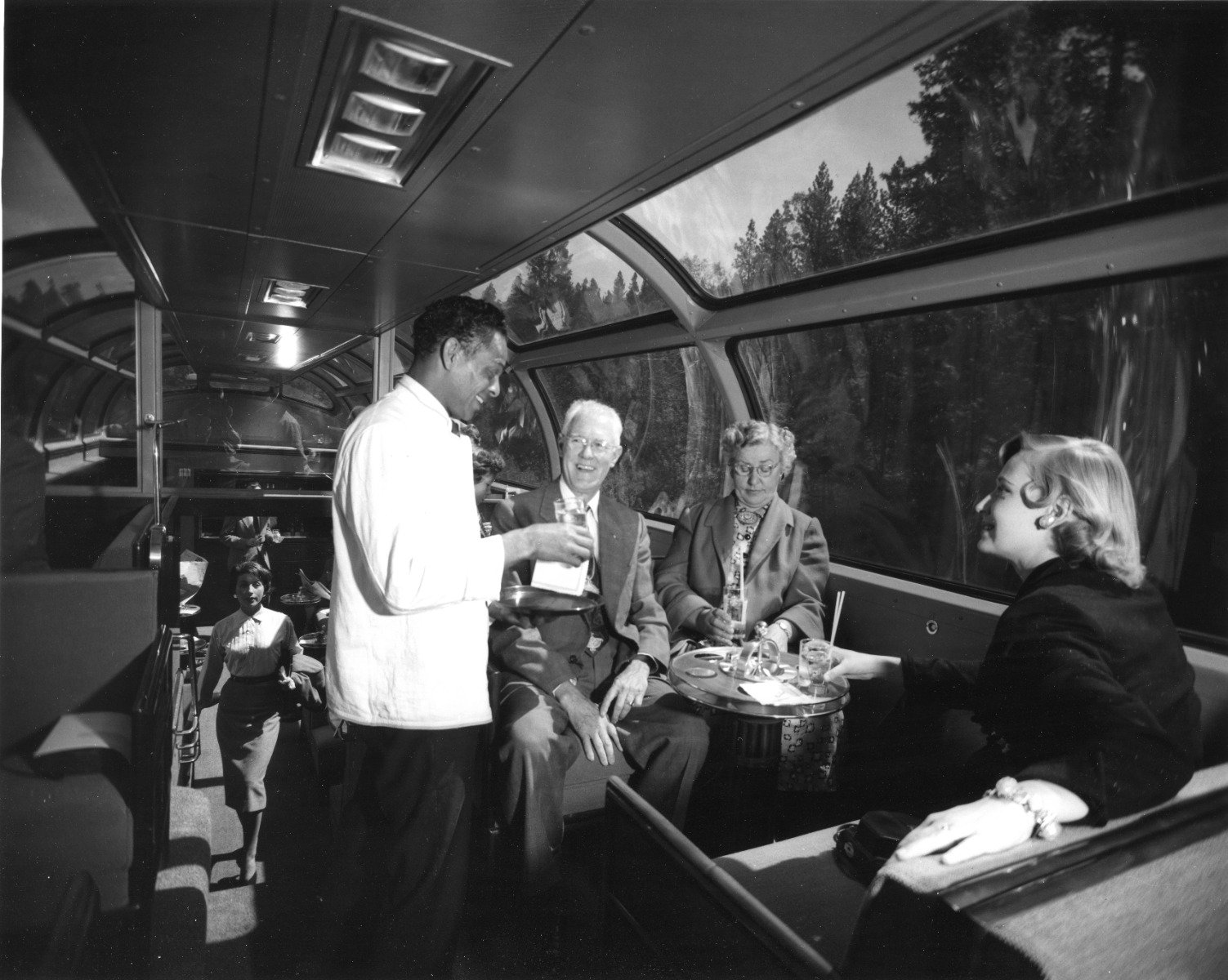
Dinner in the diner has nothing on cocktails in the dome! Or, in this case, what appears to be ice water. (Was the air conditioning having issues this day?). And nothing shows passengers relaxing through the high Sierra like men wearing suits and woman dressed to the “nines.”* It’s a good thing these cars were, indeed, very comfortable! Southern Pacific photograph, Robert J Zenk collection. (* - A phrase attributed to the Scots, who gave us so many good things: Robbie Burns, Irn Bru and bagpipes. But they also had a few missteps, such as haggis, “dressed to the nines” and golf.)
Underbody equipment arrangements also varied between the two seating floorplans, but for unconnected reasons.
SP used the center sills and salvaged body framing from retired prewar Daylight cars as a basis for its new Dome-Lounge cars, but very likely for the depreciation benefit to its accounting. This resulted in a somewhat mistaken notion that these cars were “rebuilds,” or somehow based in large part on the cars supplying the foundations. In fact, they were nearly all-new cars, utilizing only whatever salvaged frame parts might speed the process for SP’s Sacramento General Shops. Underbody equipment layout was dictated by the location of crossmembers that were salvaged from the varying placement on the donor frames.
In other words, when installing underbody equipment and appliances, sometimes the boys in the Shops had to wing it.
As a result of this “Foreman’s Choice” build situation, the placement of underbody equipment varied from a clean-sheet-of-paper design. But the basic layout was also improved between the first four cars and the Shasta Daylight twins. For example, the Waukesha propane bottle carriers — those distinctive boxes with ’sowbelly’ doors, feeding the flathead four-cylinder Waukesha compressor engines and generators — were grouped more tightly in a long single row on the Shasta Daylight pair for greater ease in servicing the propane cylinders.
Here is a quick rundown of the various cars and their ancestry:
SP 3600 – 81-feet – built 1954 – 34 dome seats (Overland-style, to be operated in one direction only) – originally SP parlor-round end observation 2950 (Pullman-Standard, built 1937) – originally painted SP Daylight Red and Orange and, after testing, was later assigned to the San Joaquin Daylight – Retired 1970 – The Rapido Trains’ model does not match this prototype.
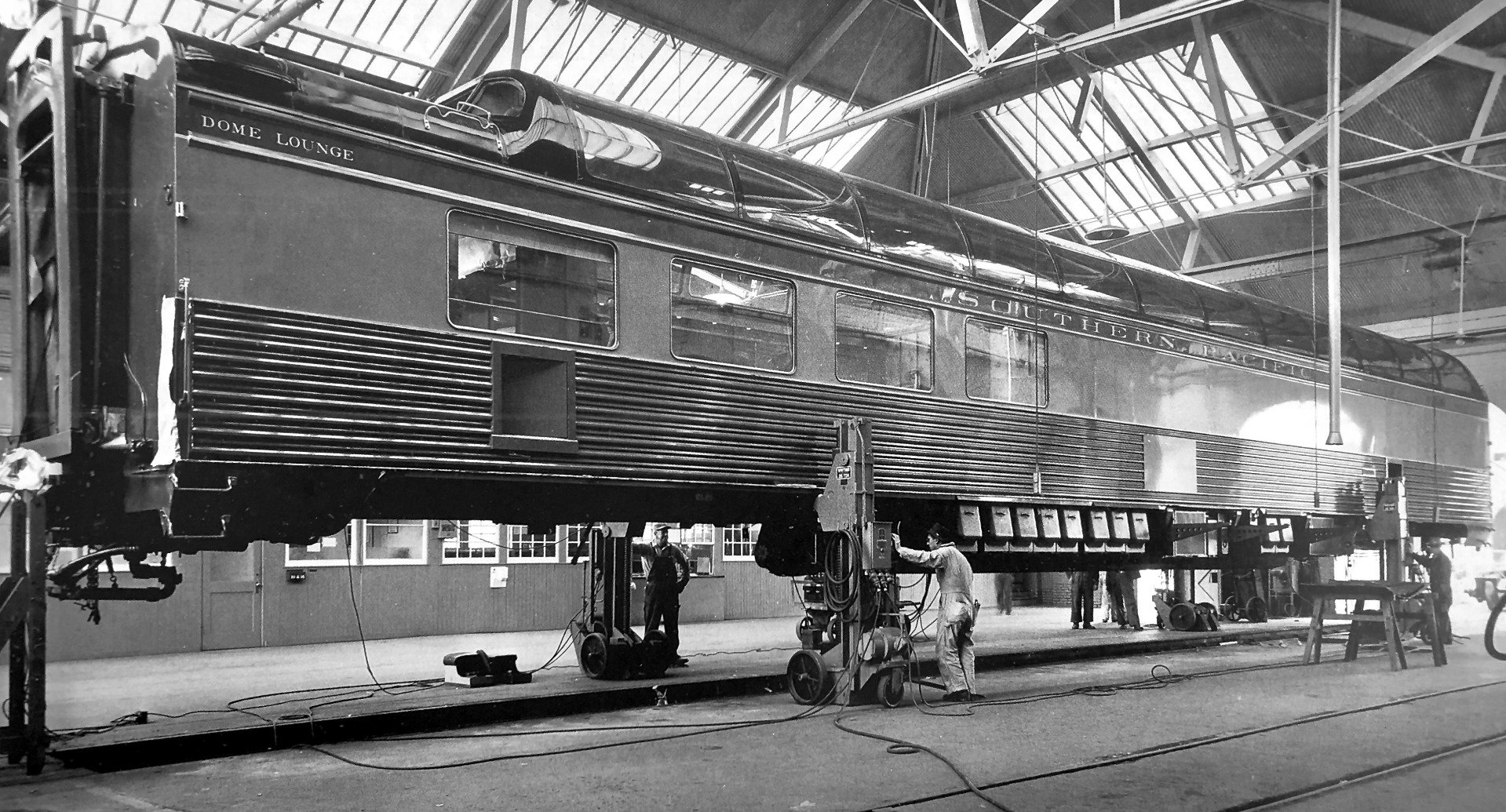
As built, the Southern Pacific’s Dome-Lounge cars wore the railroad’s iconic and colorful Daylight red and orange colors. However, as we were unable to locate any color photos of these cars in this scheme that we could use here, so you will need to use your imagination to understand how utterly beautiful these cars were when constructed, as seen here deep inside the railroad’s Sacramento General Shops of car 3604. Note the baggage loading door under the first window, and unique feature found on SP’s Daylight cars. Southern Pacific photograph, Robert J Zenk collection
SP 3601 – 85-feet – 34 dome seats (Overland-style, to be operated in one direction only) – built 1955 – originally SP subsidiary Texas & New Orleans parlor 700 (Pullman-Standard, built 1937) – originally painted Armour Yellow and Harbor Mist Gray for use on the Milwaukee Road-Union Pacific-Southern Pacific City of San Francisco – to Amtrak 9370 (1974), retired 1977
SP 3602 – 85-feet – 34 dome seats (Overland-style, to be operated in one direction only) – built 1955 – originally SP lunch counter-tavern-lounge 10311 (Pullman-Standard, built 1937) – originally painted Armour Yellow and Harbor Mist Gray for use on the Milwaukee Road-Union Pacific-Southern Pacific City of San Francisco – to Amtrak 9371 (1974)
SP 3603 – 85-feet – 34 dome seats (Overland-style, to be operated in one direction only) – built 1955 – originally SP lunch counter-tavern-lounge 10310 (Pullman-Standard, built 1937) – originally painted Armour Yellow and Harbor Mist Gray for use on the Milwaukee Road-Union Pacific-Southern Pacific City of San Francisco – to Amtrak 9372 (1974)

Not all of these cars were painted in Daylight colors when built, as illustrated by this photo of SP 3601 (the other was SP 3602) resplendent in Union Pacific colors – Armour Yellow and Harbor Mist Gray – for use on the City of San Francisco, a Chicago IL to Oakland CA train operated jointly by Milwaukee Road-Union Pacific-Southern Pacific., and with all the equipment wearing the UP’s paint scheme. The SP company photographer documented this car in Oakland. Southern Pacific photograph, Robert J Zenk collection
SP 3604 – 85-feet – 34 dome seats (Overland-style, to be operated in one direction only) – built 1955 – originally SP 29-seat parlor-1 drawing room car 3000 (Pullman-Standard, built 1937) – originally painted SP Daylight Red and Orange and initially assigned to the San Joaquin Daylight – to Amtrak 9373 (1974)
SP 3605 – 85-feet – 48 seat upper dome lounge (Shasta-style, can be operated in either direction) – built 1955 – originally SP tavern car 10312 (Pullman-Standard, built 1938) – originally painted SP Daylight Red and Orange and initially assigned to the Shasta Daylight – to Amtrak 9374 (1974)
SP 3606 – 85-feet – 48 seat upper dome lounge (Shasta-style, can be operated in either direction) – built 1955 – originally TNO diner-lounge-round end observation 950 (Pullman-Standard, built 1937) – originally painted SP Daylight Red and Orange and initially assigned to the Shasta Daylight – Retired 1971
Confused? We Don’t Blame You!
So, here (thanks to that clever rascal Robert J Zenk) is a handy list of SP dome-lounges sorted by paint scheme and years of service, and even the train assignments!
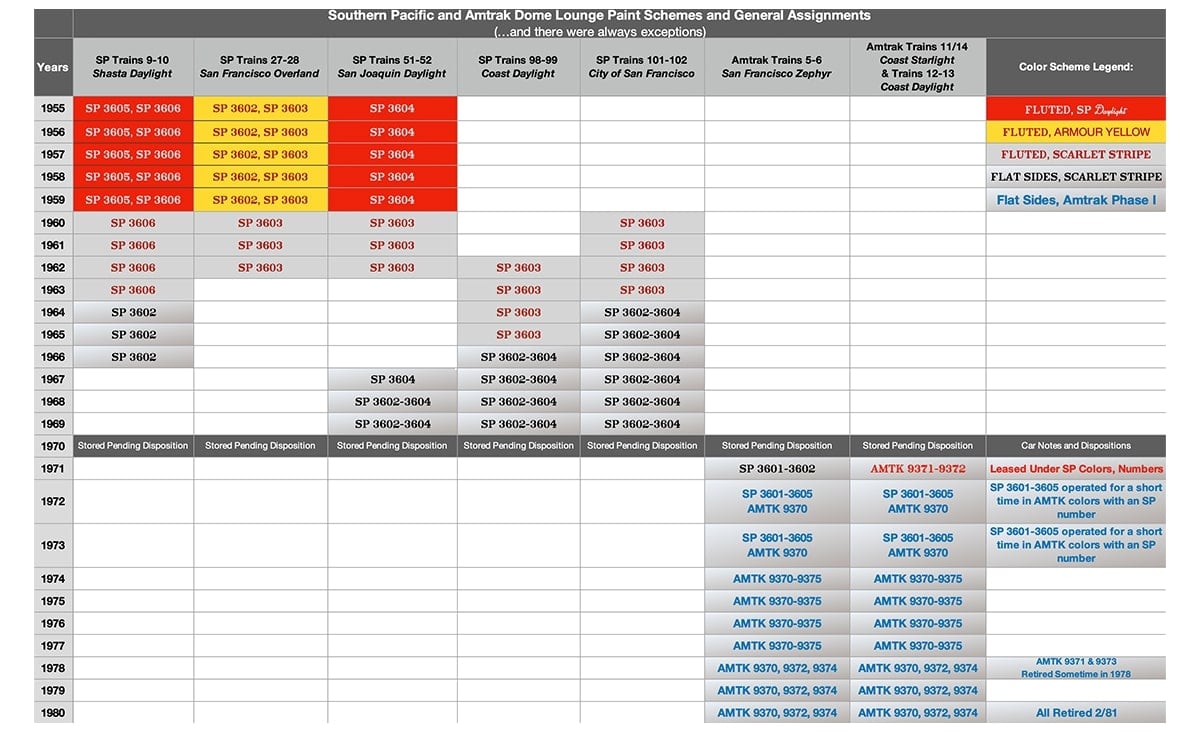
Note: This list is provided to assist those who model strictly prototype operations. Feel free to ignore it if you prefer to just purchase and operate what you like – it's your railroad, you can do what you want!
Ch-Ch-Ch-Changes
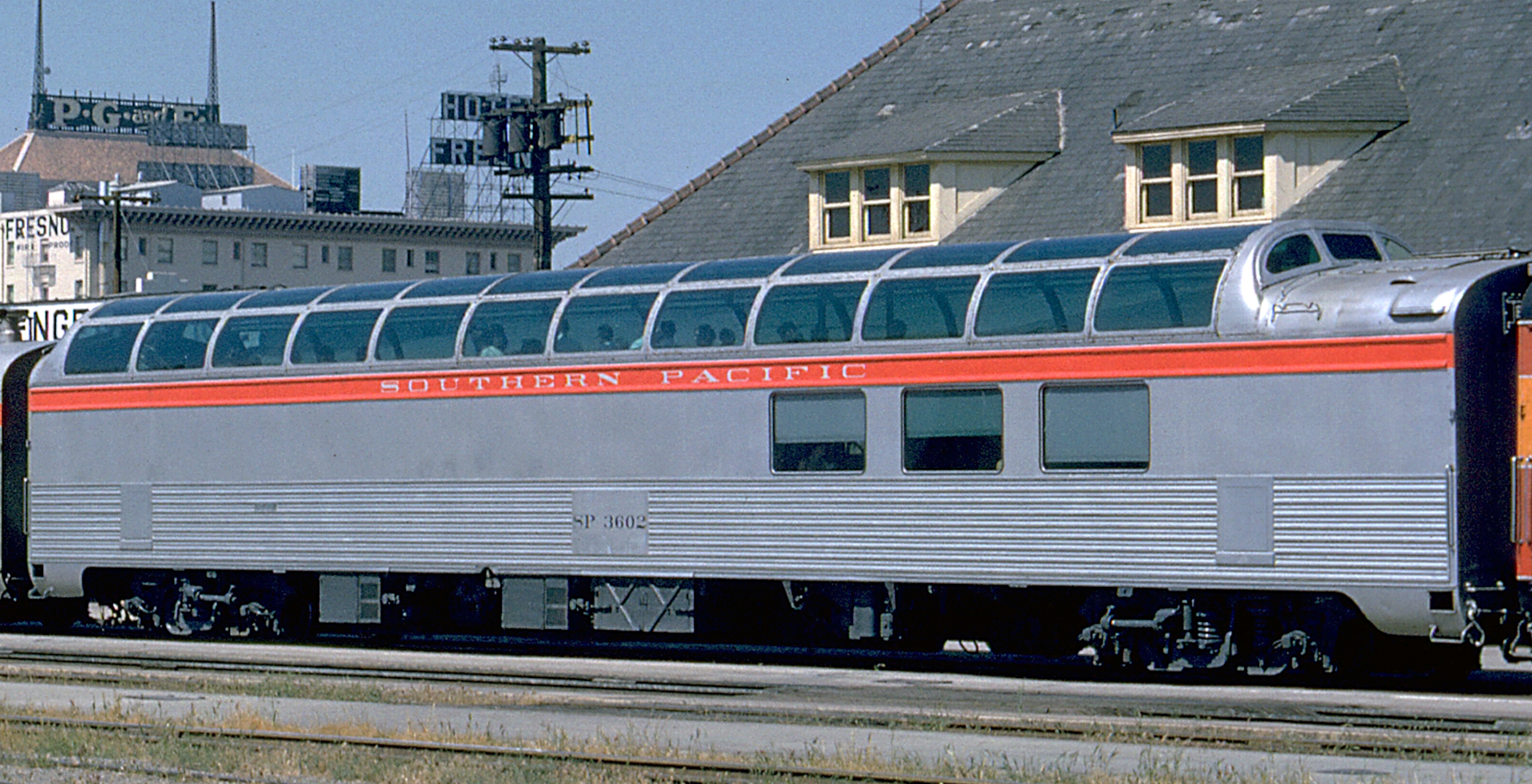
All good things come to an end, and around 1960 the mighty Southern Pacific was looking to cut costs, and a uniform paint scheme for all their passengers cars was adopted, based upon their Sunset Limited scheme: Aluminum car sides with a red letterboard stripe above the windows. This would allow more latitude with car assignments. SP Dome-Lounge 3602 was photographed in Fresno CA, most likely on the San Joaquin Daylight, in this new scheme, still with the unique to SP baggage loading door and retaining its corrugated siding … for now. Bruce R. Heard photograph, Robert J Zenk collection
Over the years, Southern Pacific assigned these cars to different trains, repainted them (in 1960 all the dome-lounge cars received aluminum corrugated sides with a red letterboard stripe), and beginning in 1963 the cars were “reskinned” with the corrugations removed in favor of flat panel sides (SP 3601 sometime after 2/63, for example).
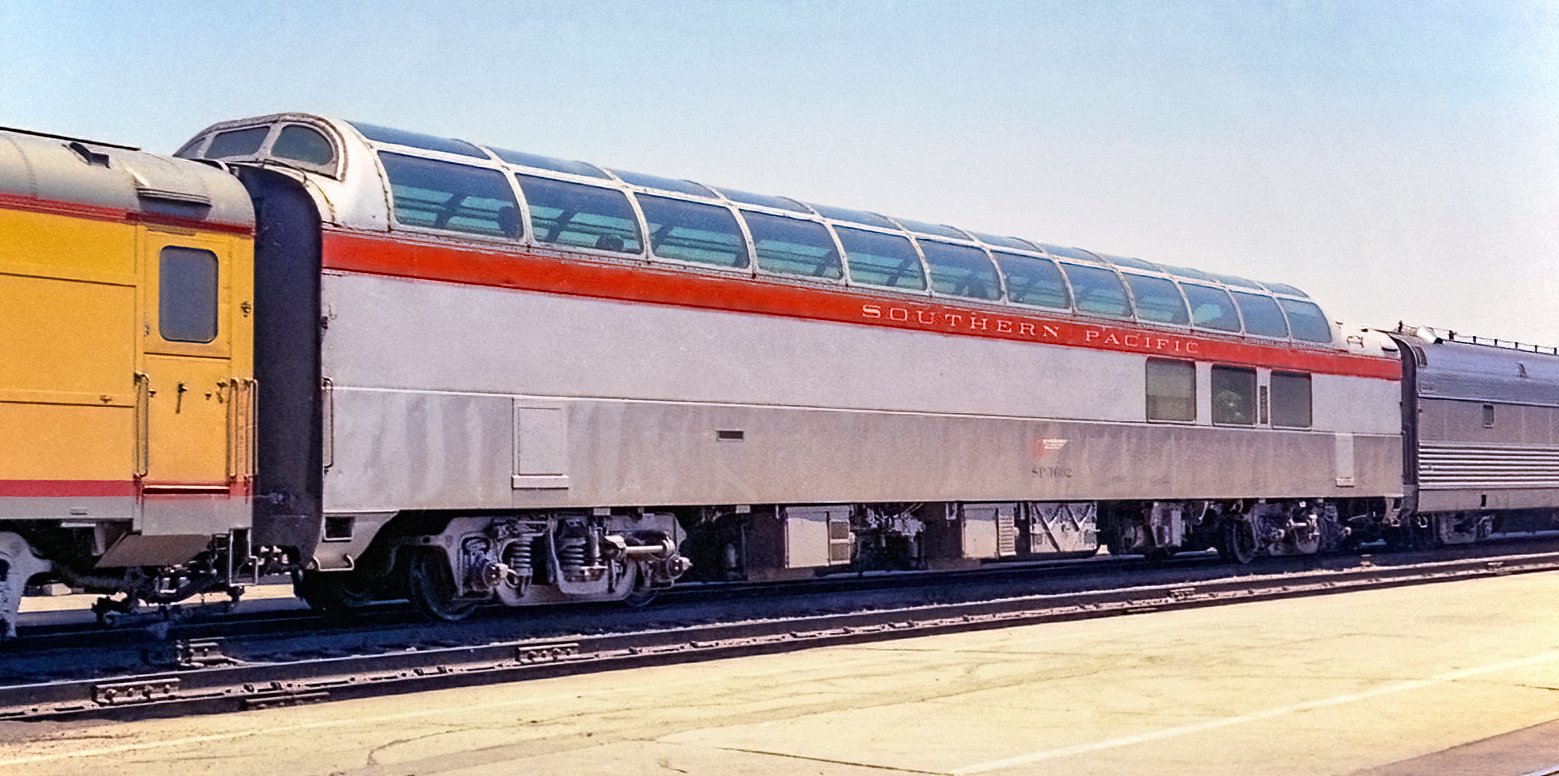
Eventually the corrugated siding was replaced with smooth aluminum sheets, as seen on SP 3602. But a bigger change was that, along with almost every other American railroad, the Southern Pacific had gotten out of the passenger train business when the National Railroad Passenger Corporation (NRPC), operating under the name Amtrak, took over operations of nearly all passenger rail service in America on May 1, 1971. (Commuter lines were exempt, and three Class I railroads – Denver & Rio Grande Western, Rock Island and Southern Railway – opted to keep operating their own passenger trains, at first.) Photographed in Sacramento CA on July 17, 1972 is Southern Pacific Dome-Lounge 3602, in Amtrak service (note the former-Union Pacific car and former-Burlington Northern (ex-CB&Q) cars on either side of it. Of note, though, is that unlike most all the cars operating on Amtrak trains, SP’s Dome-Lounges were still owned by the SP and leased to Amtrak. The underbody equipment and trucks had, however, received a coat of silver paint. Dale Martin photograph
Eventually these cars were sold to Amtrak – but, surprisingly, not until after leasing them to Amtrak for a short time first. (Apparently, being “home built” cars, Amtrak was initially hesitant to purchase these.) Even though they were leased, at least some of them were repainted into Amtrak’s paint scheme but carried SP reporting marks and car numbers!

Later still, at least some of the Southern Pacific’s Dome-Lounges had received Amtrak paint jobs, while still being owned by the SP! Note that car SP 3601 still carries an “SP” reporting mark ahead of the car number, unusual for cars used on Amtrak trains – in this case, the San Francisco Zephyr, passing through Cheyenne WY on June 24, 1973. Note that the Amtrak “Pointless Arrow” logo is not as tall as the horizontal red and blue stripes. Ron Hawkins photograph
It appears they were finally purchased by Amtrak in 1974:
AMTK 9370 – ex-SP 3601 (SP colors in 3/72, AMTK colors with SP number in 9/72)
AMTK 9371 – ex-SP 3602 (SP colors in 7/72, AMTK colors with SP number in 6/73)
AMTK 9372 – ex-SP 3603 (AMTK colors with SP number in 7/72)
AMTK 9373 – ex-SP 3604 (SP colors in 1/72)
AMTK 9374 – ex-SP 3605 (AMTK colors with SP number in 8/72)

In 1974, Amtrak finally purchased the five (now) ex-SP Dome-Lounges and renumbered them: SP 3601-3605 were now AMTK 9370-7374. Photographed on January 22, 1977, is Amtrak Dome-Lounge 9373 (ex-SP 3604) at Glendale CA on the Coast Starlight. Note that on this car, the Amtrak arrows are as tall as the striping. Ron Hawkins photograph
Amtrak disposed of these cars on these dates:
AMTK 9370 – retired 1978
AMTK 9371 – retired 2/81
AMTK 9372 – retired 1978
AMTK 9373 – retired 2/81
AMTK 9374 – retired 2/81

Passing through Santa Margarita CA, the summit of the Central Coast’s Cuesta Grade, Amtrak Dome-Lounge 9374 (ex-SP 3605) is seen on Amtrak train 14, the northbound Coast Starlight. By this date, January 26, 1978, Amtrak has replaced the dome’s upper windows with aluminum, covered with carpeting on the car’s inside. This was likely an attempt to lessen the sun shining into the car in an attempt to keep the dome’s interior cooler. Craig Walker photograph
On some of these ex-SP cars, around 1977, Amtrak upholstered the upper row of dome windows (yes, upholstery applied to steel sheets replaced the upper windows to provide shade and reduce maintenance, apparently), and also “updated” the interior color scheme … keep in mind that Amtrak at this point was not known for tasteful interiors! Along with reducing light thanks to the upholstered windows, the new colors were chocolate brown with dark wood burl contact paper. While dark, it might’ve looked like a classic professor’s office, but then they installed bright orange upholstered booth-style seating in the lower level, with mottled red and blue floral designs for the dome’s seating. We have not yet found photos of the lounge’s refrigerators, but perhaps they were “avocado”?
After Amtrak

Built by Pullman-Standard in 1937 as SP Tavern-Lounge 10312, rebuilt into SP Dome-Lounge 3605, later sold to Amtrak as AMTK 9374, and then owned by a variety of private owners and tourist railroads (and often not operable), this car was eventually sold in 2018 to the Canadian Pacific Railway and, following a year-long restoration, emerged from the railway’s Ogden Yard in Calgary AB as CP 3605, and named Selkirk. Seen on August 25, 2019 in the CP’s Royal Canadian Pacific train, departing GO Transit’s Richmond Hill Layover storage yard in Gormley ON, this rebuilt dome was impressive on the outside. And the interior exceeds the exterior for beauty. Craig Walker photograph
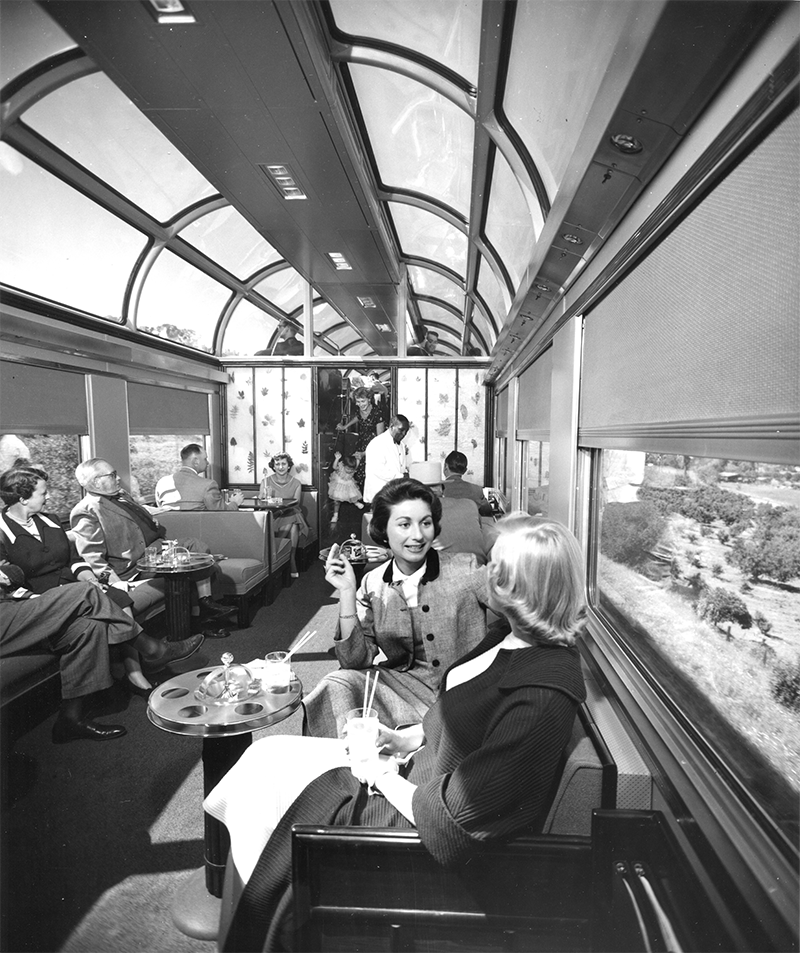

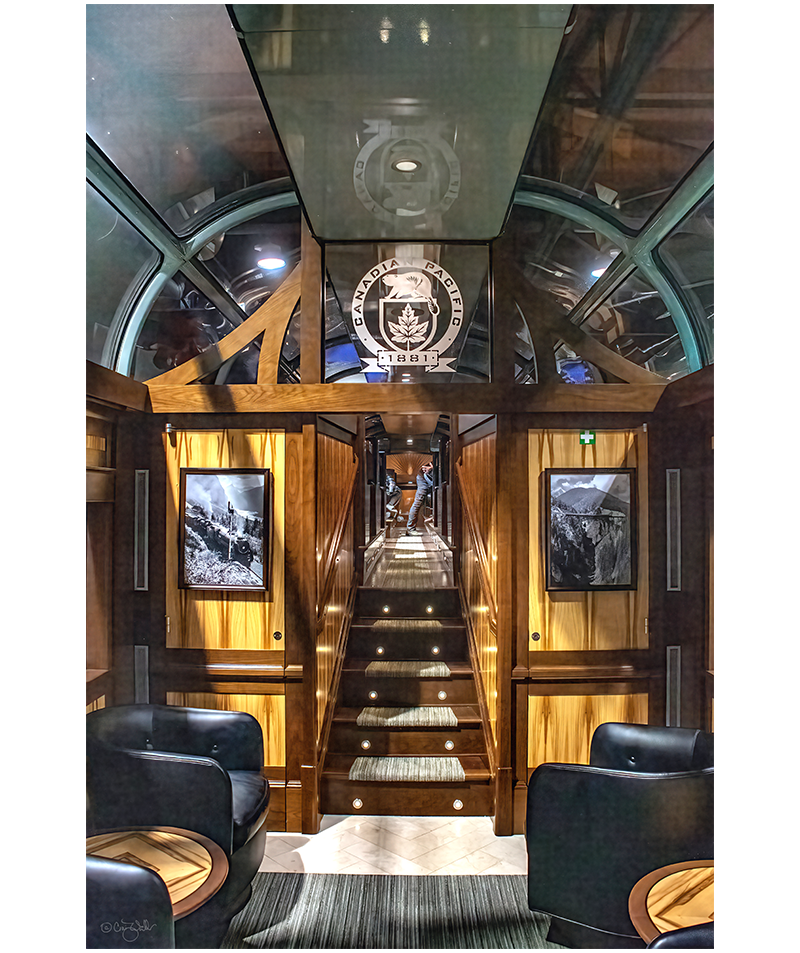

Having been built in the mid-1950s, naturally the Southern Pacific’s Public Relations photos of these cars’ interiors will be very much of that time. This view shows the lower Lounge level, looking toward the Dome section. These cars were unique in this design, in which a section of the dome was over the car’s lower level, providing an expansive feeling for those relaxing therein. (Compare this to today’s airline travel with a whopping 9" of legroom and baggage bins one hits with one’s head when heading to the smaller-than-a-phone booth restrooms! Does anyone remember phone booths?) These cars had a terrific way of letting in California’s sunny skies ... But as two of these cars were in service all the way to Chicago, after crossing the Sierra Nevada’s Donner Pass and Colorado’s Rocky Mountains, passengers had spectacular views of Nebraska’s endless flatness. (My wife is from Nebraska, so I am very familiar with that state’s terrain!) Note the distinctive panels on either side of the stairs up to the dome, which have a variety of leaves encased in the glass. And why is that woman staring at SP’s photographer?
Southern Pacific photograph, Robert J Zenk collection
Canadian Pacific acquired it from the Royal Gorge Route Railroad (in Colorado) in 2018, and the car underwent extensive rebuilding in CP’s Ogden Yard in Calgary, which required the car to essentially be rebuilt with nearly all-new material, with work completed in June 2019. Along with rebuilding this car’s superstructure, the interior was also completely reimagined, and this car now has a look somewhat reminiscent of its SP days, but with a much more elegant appearance. I remember riding in a few of these back in the 60s, and the word “Linoleum” comes to mind. Today, this car’s interior is nothing short of elegant, yet thanks to the work of CP’s crew (and, in particular, Senior Manager of Heritage Operations Kevin Hrysak and Manager of Heritage Operations and Mechanical Justin Tracy), somehow much of SP’s original design was retained, but updated with better materials (just admire all the woodwork!) and more comfortable accommodations. CP’s crews did a fantastic job on this car!
Craig Walker photograph
After retirement from Amtrak, these cars were scattered among various owners, both private owners and tourist railroads. Much of their existence during this period was unimpressive, but one owner is worth highlighting: Canadian Pacific. CP acquired the former Amtrak 9374 (ex-SP 3605) from Colorado's Royal Gorge Route Railroad in 2018, and the car underwent an extensive rebuilding in CP's Ogden Yard in Calgary, which required the car to essentially be rebuilt with nearly all-new material, both inside and out. In a nod to the car’s heritage, Canadian Pacific gave this car its old SP number back, as CP 3605, and dubbed it Selkirk (a city in Manitoba long-served by the CP, and also the name assigned to 36 2-10-4 steam locomotives operated by the CP from 1929-1959). Canadian Pacific 3605 Selkirk joined the CP’s fleet of business cars in June 2019. As of April 14, 2023, the new CPKC Railway not only owns CP 3605, but also another ex-SP Dome-Lounge in service on the Panama Canal Railway (PCRC is part of the new CPKC system) as car 102, the Rio Chagres.
Thank you to Jeff Cauthen and Don Munger for their help! Thanks, also, to Ron Hawkins and Dale Martin as well. And thank you to Peter Willard of railsimstuff.com for allowing us to use one of his fonts here.
